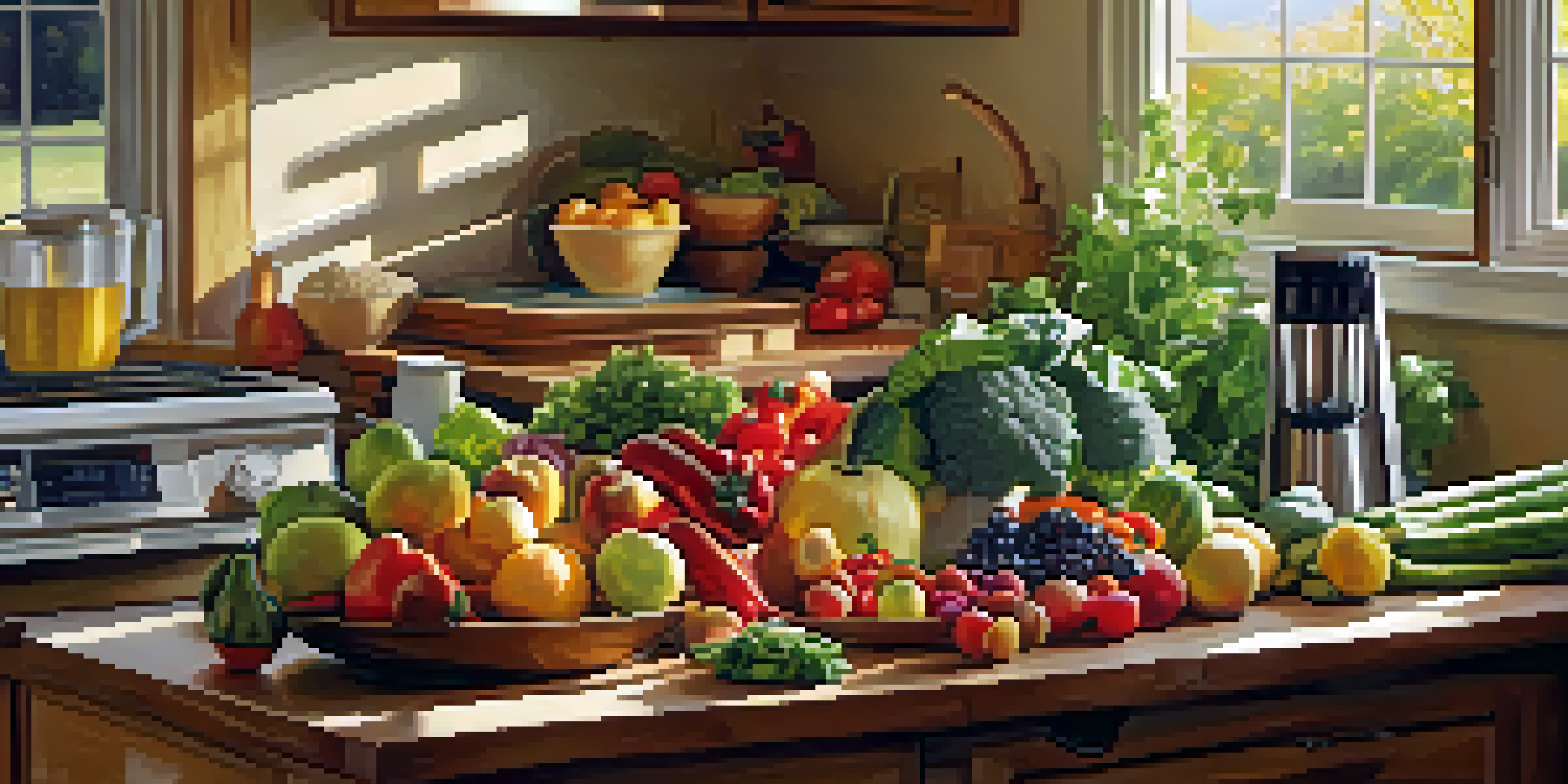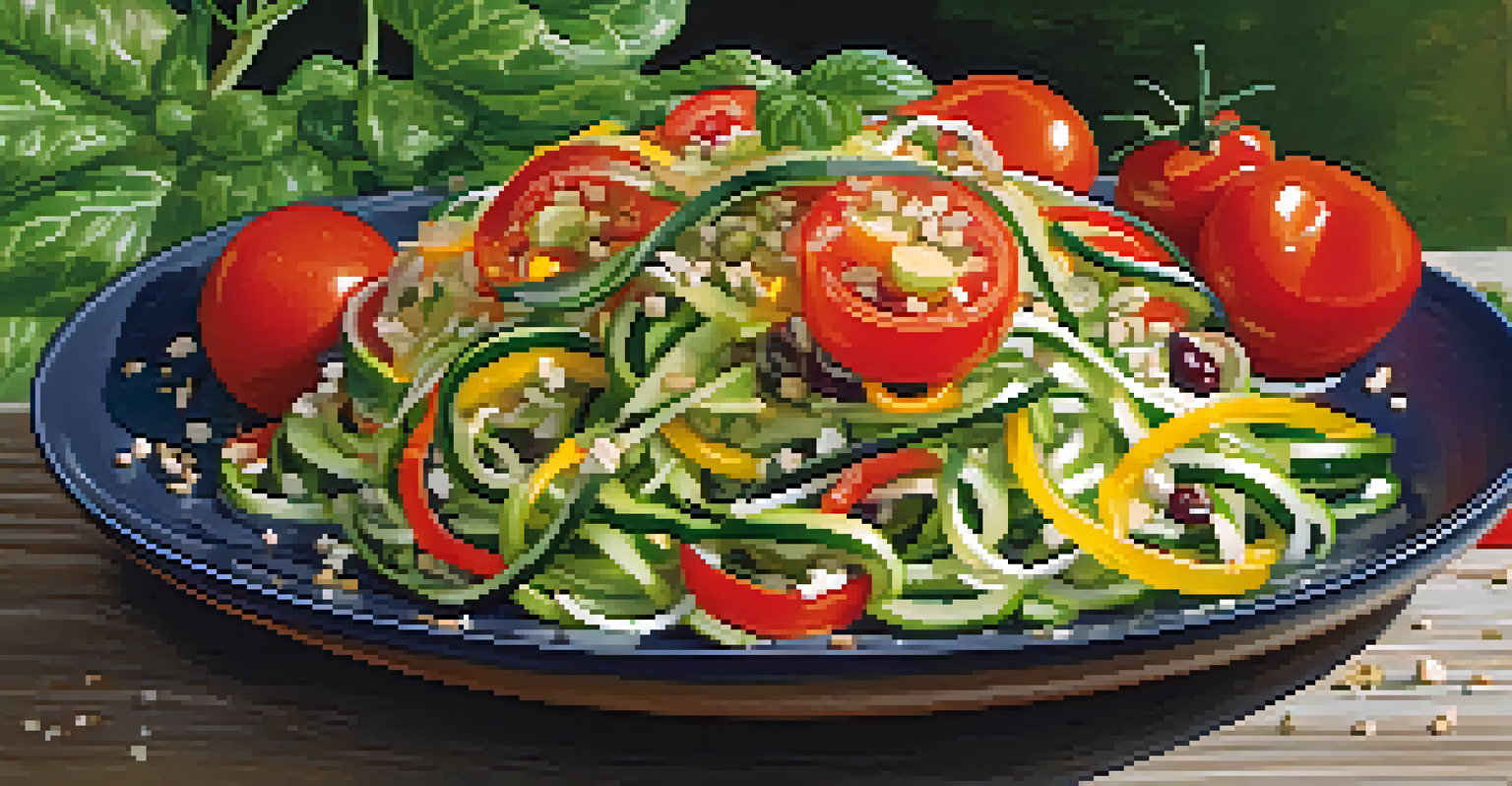Transitioning to Raw Food: Tips for a Smooth Lifestyle Change

Understanding the Raw Food Diet: What It Entails
A raw food diet primarily consists of unprocessed plant foods, including fruits, vegetables, nuts, and seeds. The idea is to consume these foods in their natural state, often avoiding anything cooked above 118°F. This approach is believed to maximize nutritional benefits and support overall health.
Let food be thy medicine and medicine be thy food.
Transitioning to raw food means rethinking your meals and snacks. Instead of reaching for that microwaveable dinner, you might find yourself blending up a refreshing smoothie or creating a colorful salad. It’s a shift that not only changes what you eat but also how you view food.
This diet can be exciting and rewarding, but it can also be overwhelming if you’re used to cooked meals. Understanding the basics of what a raw food diet involves will help you ease into this lifestyle change with confidence.
Start Slow: Gradual Introduction to Raw Foods
Diving headfirst into a raw food diet can be daunting, so it’s often best to start slow. Begin by incorporating more raw foods into your meals rather than eliminating cooked foods entirely. This could mean adding a raw salad to your dinner or swapping out a snack for fresh fruit.

Taking small steps allows your body to adjust to the new diet without feeling deprived. As you become more comfortable, you can gradually increase the proportion of raw foods in your meals. This gradual approach can make the transition feel less intimidating and more enjoyable.
Start Slowly for Raw Food Success
Transitioning to a raw food diet is easier when you incorporate more raw foods gradually rather than eliminating cooked meals all at once.
Remember, this journey is about discovering what works best for you. Enjoy the process of experimenting with new recipes and flavors at your own pace.
Essential Kitchen Tools for Raw Food Preparation
Having the right kitchen tools can make your raw food journey much easier and more fun. A good blender is a must-have for smoothies and soups, while a food processor can help you chop, slice, and create raw desserts. Investing in a high-quality spiralizer can also turn vegetables into noodle-like dishes.
The food you eat can either be the safest and most powerful form of medicine or the slowest form of poison.
These tools will not only save you time but also inspire creativity in your cooking. Imagine whipping up a vibrant zucchini noodle salad or a creamy avocado dip in minutes! The more equipped your kitchen is, the more likely you’ll enjoy the process of preparing raw meals.
Ultimately, the right tools can enhance your experience and motivate you to try new recipes, making the transition smoother.
Exploring New Recipes: Creativity in Raw Food
One of the most exciting parts of transitioning to a raw food diet is discovering new recipes. There’s a whole world of raw food cuisine waiting for you, from colorful salads to decadent raw desserts. Embrace the opportunity to experiment with new combinations of fruits, vegetables, and nuts.
Consider exploring raw food blogs or cookbooks for inspiration. You might stumble upon a fantastic recipe for raw chocolate truffles or a refreshing watermelon salad that becomes a new favorite. These dishes can help you see that raw food isn’t just healthy but can also be incredibly delicious.
Essential Tools for Raw Cooking
Having the right kitchen tools, like blenders and spiralizers, can enhance your raw food preparation experience and inspire creativity.
As you experiment, don’t be afraid to put your spin on existing recipes. Use this transition as a chance to express your culinary creativity and find joy in the kitchen.
Listening to Your Body: Intuitive Eating for Raw Foodies
As you shift to a raw food diet, tuning into your body’s signals becomes crucial. Pay attention to how different foods make you feel, both physically and emotionally. This intuitive approach can help you understand what works best for your unique body.
You may find that certain raw foods energize you while others might leave you feeling sluggish. Trusting your body’s responses will guide you in making choices that support your health. It’s all about finding balance and enjoying the foods that nourish you.
Remember, it’s okay to adjust your diet based on your body's feedback. Embracing intuitive eating can make your raw food journey more sustainable and enjoyable.
Socializing While Eating Raw: Tips for Outings
Transitioning to a raw food diet doesn’t mean you have to shy away from social gatherings. When you’re invited to a party or dining out, think about how you can navigate these situations while staying true to your new lifestyle. You might bring a raw dish to share or ask the restaurant about their raw options.
Communicating your dietary preferences with friends and family can also help ease any awkwardness. Most people are understanding and supportive, especially when they see your enthusiasm for your new way of eating. Sharing your journey can even inspire others to try new foods!
Connect with a Supportive Community
Finding a supportive community through online groups or local meet-ups can provide encouragement and motivation during your raw food journey.
Socializing while on a raw food diet can be a fun challenge, and it allows you to showcase your creativity and commitment to healthy eating.
Staying Motivated: Building a Supportive Community
Finding a supportive community can play a huge role in your raw food journey. Whether it’s online forums, local meet-ups, or social media groups, connecting with others who share your interests can provide encouragement and inspiration. You can exchange recipes, tips, and experiences that make the transition easier.
Consider joining a raw food class or workshop to meet like-minded individuals. These gatherings can spark motivation, as you learn together and share the ups and downs of the journey. Plus, it’s a great way to make new friends who appreciate your lifestyle choices.

Remember, having a support system can help you stay committed and inspired as you navigate your transition to a raw food diet.